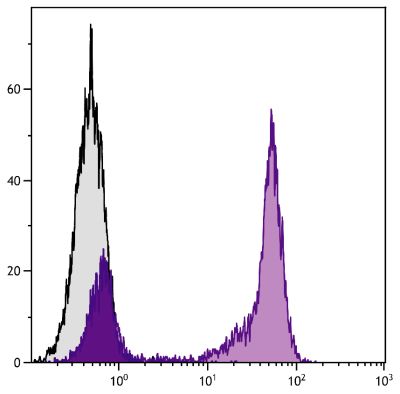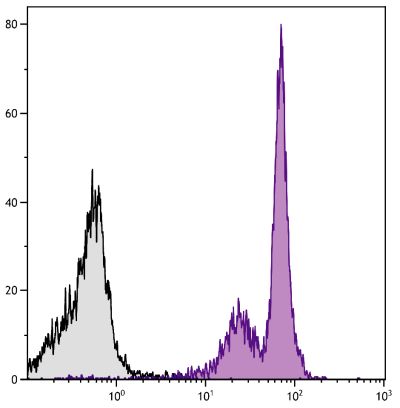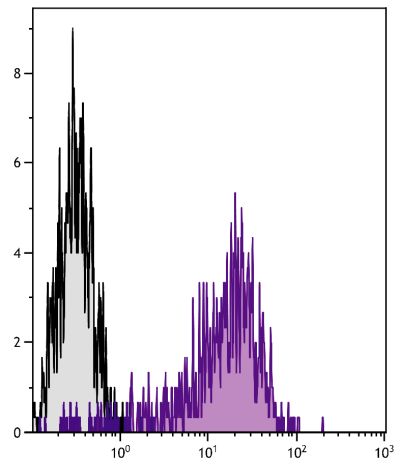Rat Anti-Mouse CD117-PACBLU (2B8)
Cat. No.:
1880-26
Pacific Blue™ Anti-Mouse CD117 antibody for use in flow cytometry assays.
$230.00
| Clone | 2B8 |
|---|---|
| Isotype | Rat (Wistar) IgG2bκ |
| Isotype Control | Rat IgG2b-PACBLU (KLH/G2b-1-2) |
| Specificity | Mouse CD117 |
| Alternative Names | c-Kit, mast cell growth factor, stem cell factor, steel factor, SCF |
| Description | The CD117 (c-Kit) antigen is the cell-surface receptor for stem cell factor (SCF). Together these molecules constitute a ligand/receptor pair which functions to maintain normal hematopoiesis in the adult. Signaling through SCF/c-Kit has an important role in stimulating myeloid and erythroid production of primitive hematopoietic progenitor cells. A variety of cytokines act synergistically with SCF to stimulate proliferation and differentiation of bone marrow progenitor cells. For example, SCF plus IL-7 can stimulate the combined myeloid and B cell differentiation of uncommitted hematopoietic progenitor cells. SCF/c-Kit also participates in erythropoiesis in both the bone marrow and spleen. Loss-of-function mutations for SCF/c-Kit lead to a variety of pleiotropic developmental defects while gain-of-function mutations can lead to constitutive activation of the kit receptor and links to cancer. Examples of the former are mast cell deficiency and severe macrocytic anemia while the latter mutation has been identified in mastocytomas. |
| Immunogen | Mouse IL-3-dependent bone marrow mast cells |
| Conjugate | PACBLU (Pacific Blue™) |
| Buffer Formulation | Phosphate buffered saline containing < 0.1% sodium azide |
| Clonality | Monoclonal |
| Concentration | 0.5 mg/mL |
| Volume | 0.2 mL |
| Recommended Storage | 2-8°C; Avoid exposure to light |
| Trademark Information | Pacific Blue™ is a trademark of Thermo Fisher Scientific, Inc. or its subsidiaries |
| Applications |
Flow Cytometry – Quality tested 1,4-8 Immunohistochemistry-Frozen Sections – Reported in literature 2 Immunocytochemistry – Reported in literature 3 Immunoprecipitation – Reported in literature 1 |
| RRID Number | AB_2795433 |
| Gene ID |
16590 (Mouse) |
| Gene ID Symbol |
Kit (Mouse) |
| Gene ID Aliases | Bs; CD117; Fdc; Gsfsco1; Gsfsco5; Gsfsow3; SCO1; SCO5; SOW3; Ssm; Tr-kit; W; c-KIT |
| UniProt ID |
P05532 (Mouse |
| UniProt Name |
KIT_MOUSE (Mouse) |
Documentation
Certificate of Analysis Lookup
Enter the Catalog Number and Lot Number for the Certificate of Analysis you wish to view
- 1. Ikuta K, Weissman IL. Evidence that hematopoietic stem cells express mouse c-kit but do not depend on steel factor for their generation. Proc Natl Acad Sci USA. 1992;89:1502-6. (Immunogen, FC, IP)
- 2. Podd BS, Thoits J, Whitley N, Cheng H, Kudla KL, Taniguchi H, et al. T cells in cryptopatch aggregates share TCR γ variable region junctional sequences with γδ T cells in the small intestinal epithelium of mice. J Immunol. 2006;176:6532-42. (IHC-FS)
- 3. Åbrink M, Grujic M, Pejler G. Serglycin is essential for maturation of mast cell secretory granule. J Biol Chem. 2004;279:40897-905. (ICC)
- 4. Hodek M, Vávrová J, Šinkorová Z, Mokŕy J, Filip S. Hematopoietic recovery after transplantation CD117+ B220-(LacZ+) bone marrow cells in lethally irradiated mice. Acta Medica. 2008;51:37-41. (FC)
- 5. Filip S, Mokŕy J, Vávrová J, Čížková D, Šinkorová Z, Tošnerová V, et al. Homing of lin-/CD117+ hematopoietic stem cells. Transfus Apher Sci. 2009;41:183-90. (FC)
- 6. Adhikari AS, Agarwal N, Wood BM, Porretta C, Ruiz B, Pochampally RR, et al. CD117 and Stro-1 identify osteosarcoma tumor-initiating cells associated with metastasis and drug resistance. Cancer Res. 2010;70:4602-12. (FC)
- 7. Filip S, Mokŕy J, Vávrová J, Čížková D, Šinkorová Z, Mičuda S, et al. Splenectomy influences homing of transplanted stem cells in bone marrow-ablated mice. Stem Cells Dev. 2012;21:702-9. (FC)
- 8. Ikami K, Tokue M, Sugimoto R, Noda C, Kobayashi S, Hara K, et al. Hierarchical differentiation competence in response to retinoic acid ensures stem cell maintenance during mouse spermatogenesis. Development. 2015;142:1582-92. (FC)
See All References






